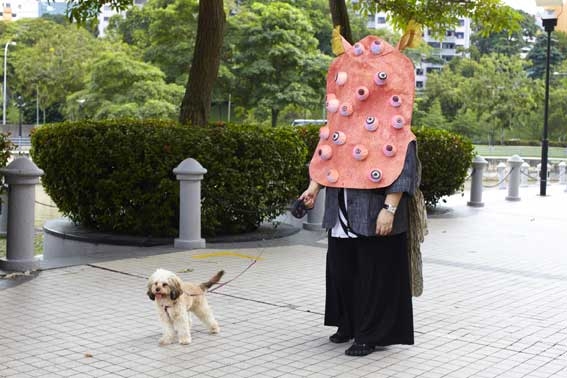Eko Nugroho breaks new ground at the Singapore Tyler Print Institute (STPI) through a strategy of multiple interventions in the realms of the social, political and institutional. Known for bringing art to public spaces, Nugroho works across different disciplines and media to transform sites and spaces with murals, site-specific installations, artist’s books, comics, video, embroidered textile works and even the Wayang Bacor project, for which he collaborated with wayang kulit (shadow puppet) performers to reinvigorate this traditional performing art as a twenty-first century medium.
We Are What We Mask plays on the mask or topeng used in ritual mask dances in Bali and Java to endow the dancer with the spirit of what the mask represents (generally gods, demons and animals). Nugroho adopts the mask (full-face and sculpted from paper, in collaboration with the paper and print makers at STPI) to allow wearers to transcend their identities (be it gender, ethnicity, religious beliefs or nationality) and subsequently to intervene in different social spaces and contexts in Singapore.
Nugroho’s approach to artmaking is a collaborative one; consequently, the STPI staff members who wore the masks were allowed to select the ones they preferred and to decide at which public site they would eventually be photographed wearing it and provoke reactions and responses from the public. Each mask features a text such as ‘Obey and be Happy’, ‘Life is Left or Right’, ‘While Money is in Our Hands, There Will Be Hope in Our Lunch and War in Our Dreams’, and ‘Faith in Shopping’. Covering the face of its wearer, each appears in a quotidian scene – on trains or in hawker centres, taxi queues and tourist sites – in a manner that highlights and questions the everyday values and mental states embraced by Singaporeans: consumerism, social conservatism, political apathy, uncritical obedience to authority, and the slavish pursuit of economic success. Thus, the act of masking becomes part of the process of unmasking social conventions and norms.
Nugroho’s masks draw from mask traditions beyond Indonesia, including the Mexican Lucha Libre, biohazard headgear and Islamic headdresses and veils. When the masks are displayed in the sanctity of the white cube space in vitrines at STPI, Nugroho delivers his final critique – an unmasking of institutional spaces and a history of exhibitions steeped in long histories of Euro-centricism: until fairly recently, spaces such as these did not acknowledge the existence of contemporary art from countries outside Europe and America, and displayed works such as Nugroho’s masks in an ethnographic context rather than an artistic one.
This article was first published in the November 2013 issue.
